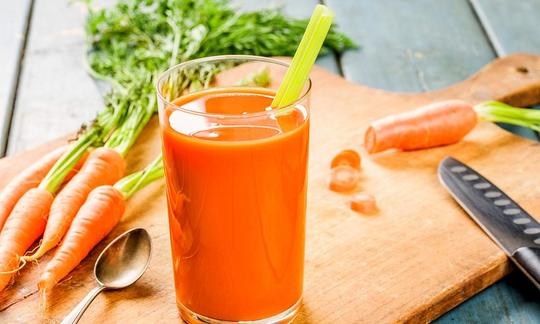Table of contents
Fresh carrot juice is made from pressed (juiced) carrots. The carrot juice gets its color from the beta-carotenes, which are found in particularly high concentrations in carrots.
Using carrot juice in the kitchen:
You can drink freshly squeezed carrot juice (organic) pure, mix it with other vegetable and fruit juices or use it instead of water in recipes. You can refine the juice with a little grated ginger or turmeric or mix it with orange and lemon juice. To better absorb the fat-soluble nutrients, combine it with avocado and other vegetables and fruits and mix yourself a smoothie.
What is carrot juice good for? Carrot juice can be used as a natural colorant in cooking and baking, for example in pumpkin and oat snacks. A carrot risotto made with vegetable stock and carrot juice will have a much more intense color than without. Bread and cake dough will also have a light orange color, which can be enhanced by adding ground turmeric.
The press residue (pomace) that is created when making the juice can be used for pomace oat dessert balls or a carrot and macadamia cake, for example. Alternatively, you can add it to a vegan Bolognese sauce instead of fresh carrots.
Vegan recipe for carrot risotto with carrot green pesto:
Ingredients (for 4 people): 500 g carrots with cabbage, 1 onion, 300 g short grain rice (risotto rice), approx. 9 dl vegetable stock, 3 dl carrot juice, 40 g nuts ( walnuts, macadamia nuts), 2-3 tbsp yeast flakes, salt,black pepper. Parsley can be used as an alternative to the carrot greens.
Preparation: Cut the carrot tops from the turnip and put to one side. Wash the carrots and cut into small pieces. Peel and chop the onions. Lightly sauté the onions and carrots. Add the rice and sauté briefly. Deglaze with a little vegetable stock. First add the remaining vegetable stock, then the carrot juice little by little. Simmer for about 20 minutes, stirring occasionally, until the risotto is creamy. In the meantime, wash the carrot tops and chop roughly. Alternatively, you can also use parsley. Puree the tops in a blender together with nuts and yeast flakes. Season with salt and pepper. Divide the risotto between plates and garnish with pesto.
Vegan recipes with carrot juice can be found under the note: " Recipes that have the most of this ingredient ".
| Not only vegans or vegetarians should read this: Vegans often eat unhealthily. Avoidable nutritional mistakes. |
Shopping - where to buy carrot juice?
Carrot juice can be found in the range of large supermarket chains such as Coop, Migros, Denner, Volg, Spar, Aldi, Lidl, Billa, Rewe, Edeka or Hofer. Carrot juice can often be bought in organic supermarkets such as Denn's Biomarkt or Alnatura. Carrot juice is available all year round. The carrot juice available in stores is pasteurized and is therefore no longer raw. Sometimes you can also get lactic acid fermented juice. Fermentation takes place through lactic acid bacteria. Raw juice must always be freshly squeezed and does not keep for long, which is why it can usually only be bought in juice bars.
The availability of carrot juice in the supermarkets mentioned varies depending on the size of the store, catchment area, etc. If you are interested, click on our recorded food prices for the DA-CH countries (above under the ingredient image). There you will find current prices from various supermarkets and their price development.
Homemade - how to make carrot juice?
Since vegetables generally have a firmer structure and a lower water content than fruit, real vegetable juice can often only be made with a juicer. Before processing, you should wash the vegetables (here the carrots) thoroughly and cut them into large pieces. The juicer chops up the vegetable pieces and produces the desired liquid. The solid residue that can be reused is called pomace. It is advisable to drink the vegetable juice immediately or freeze it because its nutrients are sensitive to heat, oxygen and light.
A green smoothie is something completely different and usually consists of the corresponding vegetables plus a fruit such as an apple in the blender. In contrast to a juicer, with a blender all the vegetables remain in the slightly stiff liquid. For an additional taste sensation, you can add a little grated ginger or another spice.
Wildly found:
For information, see the ingredient carrot.
Storage:
Freshly squeezed carrot juice should be drunk immediately or frozen if possible. Pasteurized carrot juice can be kept in the fridge for a few days after the bottle has been opened. In terms of valuable ingredients, it is inferior to home-made or mixed juices or smoothies, unless it contains artificial additives.
Carrot juice ingredients - nutritional values - calories:
Freshly squeezed carrot juice (organic) contains 40 kcal per 100 g and is therefore low in calories. The protein content is low at 0.95 g/100g and there is also hardly any fat at 0.15 g/100g. It contains 9.3 g/100 g carbohydrates, of which 3.9 g is sugar. The fiber content is 0.8 g/100 g. Carrot juice also contains 168 mg/100 g salt, which corresponds to 7.0% of the daily requirement. 1
Carrot juice is known for its high content of vitamin A, known as RAE. This is present as provitamin A in the form of carotenoids. 100 g of carrot juice contains 956 µg, which covers 120% of the daily requirement. One glass of juice can cover your daily vitamin A requirement. Dried goji berries (1341 μg) are also rich in vitamin A. Sweet paprika powder (6042 μg), hot paprika powder (2463 μg), and chili powder (1483) contain a lot of provitamin A, but people usually only eat 1 g of it, which is why the content per portion is small. 1
Vitamin K is also present. 100 g of carrot juice contains 16 μg of it, which covers 21% of the daily requirement. Pomegranate, cauliflower and cucumber have the same content. Raw kale (705 μg/100g) and chard (830 μg/100g) have very high vitamin K values. This corresponds to 940% and 1107% of the recommended daily dose. 1 The absorption rate is 20 - 70% (absorption rate of the vitamin in the body). Toxic properties of vitamin K from food are not known. 4
Vitamin B6 is contained at 0.22 mg/100g. This corresponds to 16% of the daily requirement. Summer squash, green bell peppers, Brussels sprouts and tempeh have the same content. Brewer's yeast (4.4 mg/100g) and yeast flakes (2.9 mg/100g) contain a lot of vitamin B6. These contents correspond to 315% and 207% of the daily requirement of vitamin B6 respectively. 1
The complete ingredients of carrot juice, the coverage of the daily requirement and comparison values with other ingredients can be found in our nutrient tables. In the article Nutrients explained you will get a detailed insight into the topic.
Dangers - Intolerances - Side effects:
Excessive consumption of carrots can lead to yellowing of the insides of the hands (and feet) and face (carotenemia, carotenoderma). However, this is more likely to be a good sign than an excess or illness. The discoloration is caused by the storage of beta-carotene or other carotenoids in the skin. It is reversible and disappears as soon as the consumption of carotenoids is reduced. 5
Can you get a vitamin A overdose from carrots? Outside of pregnancy, the toxic effect of high doses of vitamin A is not important. Acute or chronic overdoses of vitamin A have only been described in isolated cases, mostly in children after taking medication. For safety reasons, it is recommended to avoid high doses of vitamin A if you are trying to get pregnant or in the first trimester. 4 carrots do not contain vitamin A, but provitamins, and the body can store these without any disadvantages.
If you mix carrots with other vegetables, however, you should be careful not to get too much oxalic acid, as this can lead to the formation of kidney stones. If you also make sure you get plenty of vitamin C, e.g. with lemon juice, and are careful with spinach, beetroot, purslane and parsley, you'll be on the safe side. The maximum is never the optimum that the body needs.
Health aspects - effects:
How healthy is carrot juice? Carrot juice is healthy because it contains many valuable vitamins and minerals (see nutrient table under ingredients picture). The high carotene content (mainly α- and β-carotenes, so-called provitamin A) is particularly important. Vitamin A is essential for good vision; a deficiency leads to corneal clouding and blindness. It is also involved in the formation of skin, mucous membranes and bones. 4
The bioavailability of carotenoids depends on factors influencing the food and how it is prepared and processed. The factors influencing the food itself are the subject of current research and cannot be influenced by the consumer. 7 On the other hand, the careful preparation of a food can noticeably increase the absorption of carotenoids. Factors such as adding fat, chopping or cooking increase their accessibility and thus their absorption. 8 Chopping plays the biggest role here. 7,8 When it comes to fat intake, natural fats such as nuts ( macadamia, walnuts, etc.) or avocado are sufficient. 7,9 We now know that the earlier claim that added fat is needed to absorb carotene is not true.
When making carrot juice, the vegetable is chopped. Since the plant cell tissue partially dissolves during the vegetable juice production, this leads to an improved release of bioactive, health-promoting ingredients from the vegetable matrix, which should ultimately increase the bioavailability of these substances. 6
Drinking carrot juice can support an otherwise healthy and balanced diet. However, juice should only be consumed occasionally and not in large quantities. Vegetable juices are preferable to fruit juices as they contain less sugar. The daily consumption of large quantities of fruit and/or vegetable juice and smoothies should be avoided. The exception is as part of a time-limited juice cure (fasting cure).
Occurrence - Origin:
The origin of the carrot is unclear. Possible areas of origin are thought to be in northern Africa, the Middle East and southern Europe. 2 The cultivated carrot could be a cross between the wild carrot ( Daucus carota subsp. carota) and the giant carrot ( Daucus carota subsp. maximus). However, it is also possible that it originates from the black carrot ( Daucus carota subsp. afghanicus). 2 According to the FAO, the most important growing countries in 2020 are China, Uzbekistan, the USA, Russia, Ukraine and Germany. 3
Growing in the garden or as a potted plant:
Carrots can be grown well in the garden or in a pot. You can find out more about this under the ingredient carrot.
Cultivation - Harvest:
Information on cultivation and harvesting can be found under Carrot.
Industrial production:
Industrial vegetable juice production is carried out using several machines and according to the following procedure: First, the carrots are washed thoroughly, then they are peeled and blanched (at approx. 55 °C), then they are chopped. The mash is heated again at 70 - 75 °C for approx. 5 minutes. The liquid mash part is separated using a decanter, then the juice is pasteurized (direct juice) or concentrated (juice concentrate). The separated solid part of the mash (pomace) is left as processing residue. 6 Since the carrots are heated several times, this juice is no longer of raw food quality.
General information:
The carrot ( Daucus carota subsp. sativus) belongs to the family Apiaceae and is closely related to parsnip ( Pastinaca sativa), root parsley ( Petroselinum crispum) and celery ( Apium graveolens). 2
Vegetable juices are liquid products made from vegetables. Vegetable juices diluted with water are called vegetable nectar. Vegetable juices are practically 100 percent vegetable. Vegetable juices are sometimes seasoned with salt, vinegar, herbs and spices, as well as types of sugar. There are also lactic acid fermented juices. 10 Carrot juice sometimes contains honey and has a sugar content that should not be underestimated. 11
Literature - Sources:
Bibliography - 11 Sources
| 1. | USDA United States Department of Agriculture. |
| 2. | Plantura.garden. Karotte: Herkunft, Wachstum & Vermehrung. |
| 3. | FAOSTAT Food and Agriculture Organization of the United Nations. Carrots and turnips. 2020. |
| 4. | Biesalski H K, Grimm P. Taschenatlas der Ernährung. Stuttgart: Georg Thieme Verlag; 2015, 6. Auflage. |
| 5. | Maharshak N, Shapiro J, Trau H. Carotenoderma. A review of the current literature. Int J Dermatol. 2003 Mar;42(3): 178-81. |
| 6. | Orgprints.org. Bundesforschungsanstalt für Ernährung und Lebensmittel. Institut für Verfahrenstechnik. Verarbeitungseigenschaften und gesundheitliche Qualität von industriell hergestellten Karottensäften aus ökologisch erzeugten Karotten. 2005. |
| 7. | Priyadarshani AM. A review on factors influencing bioaccessibility and bioefficacy of carotenoids. Crit Rev Food Sci Nutr. 2017 May 24;57(8): 1710-1717. |
| 8. | Hedrén E, Diaz V, Svanberg U. Estimation of carotenoid accessibility from carrots determined by an in vitro digestion method. Eur J Clin Nutr. 2002 May;56(5): 425-30. |
| 9. | Unlu NZ, Bohn T, Clinton SK, Schwartz SJ. Carotenoid absorption from salad and salsa by humans is enhanced by the addition of avocado or avocado oil. J Nutr. 2005 Mar;135(3): 431-6. |
| 10. | Bundeszentrum für Ernährung. Gemüsesäfte. Gesunde Fitmacher. |
| 11. | CUVA Stuttgart. Gemüsesaft - Gemüse zum Trinken. |









Comments